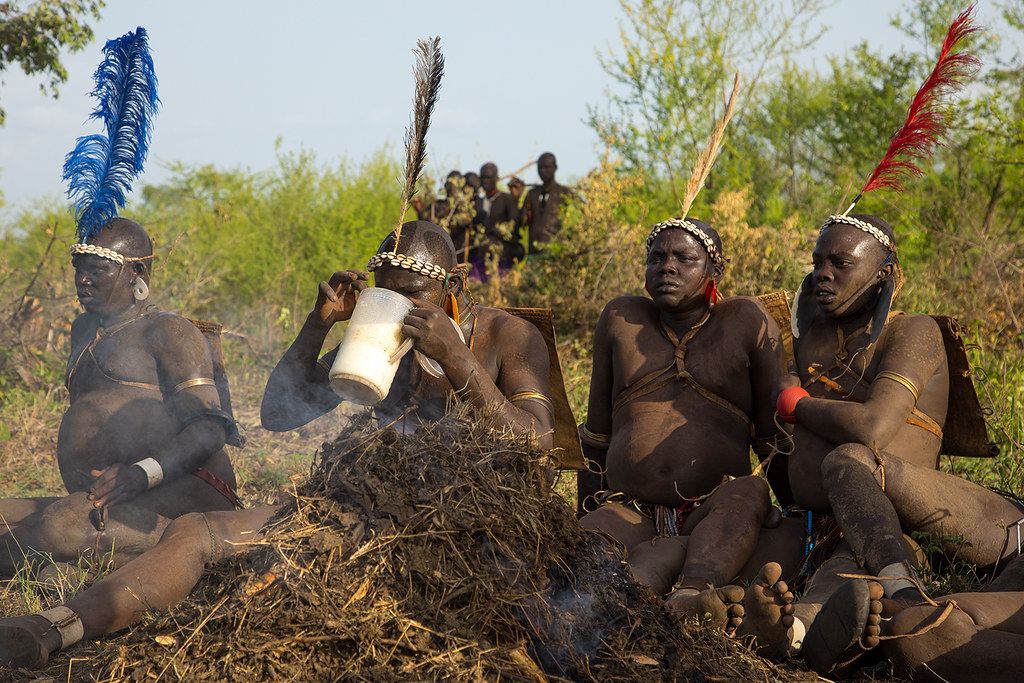The Ka’el Festival is an annual coming-of-age contest held by the Bodi tribe in Ethiopia.
Young men isolate and gorge on a cow’s blood-milk mixture for months to gain weight.
The fattest, most “beautiful” contestant is crowned as the tribal hero for the year.
This rite symbolizes strength, fertility, masculinity, and clan status.
It’s strictly traditional—outsiders are rarely allowed, and the process is deeply spiritual.
Ka’el Festival: The Brutal Race to Get Fat and Win Glory in Ethiopia’s Bodi Tribe
A Quick Recap of This Story
The Sacred Stage of Transformation
Hidden deep in Ethiopia’s Omo Valley lies a tradition that defies conventional ideas of beauty and strength. Among the semi-nomadic Bodi (also known as Me’en) tribe, the Ka’el Festival is a once-a-year event that transforms lean young men into swollen symbols of masculinity. It is not about war or dancing—but about fat, endurance, and symbolic fertility.
The Ka’el is more than a contest. It is a ceremonial proving ground, where body, tradition, and status collide in one of Africa’s most visually striking cultural rites.
The Ritual of Isolation and Consumption
The festival preparation begins six months before the big day. Young unmarried men, chosen by their families, are sequestered in huts, away from women and most social interaction. During this period, they begin a brutal daily regimen of drinking a specially prepared mixture—a thick blend of cow’s blood and raw milk, consumed in enormous quantities, often from large gourds.
There is no solid food, no physical activity, and virtually no contact with the outside world. The purpose? To gain as much body fat as humanly possible. Vomiting is common; discomfort is expected. But giving up is dishonor. Each man must push through the nausea, bloating, and heat, transforming his body into a walking symbol of tribal abundance.
The Day of Judgment
When the six months end, the village gathers for Ka’el. The men emerge—slowly, heavily, sometimes needing help to walk. They are covered in ashes or ochre, their swollen bellies leading the way. This is not a bodybuilding show. There are no muscles to flex. The victor is the man who has gained the most weight and symmetry, appearing strong, round, and full of life.
The contest is accompanied by chants, drumming, and ritual songs, with elders and women cheering. The winner is not awarded money or material gifts. Instead, he is celebrated as a hero, gaining prestige for his family and clan. For the year that follows, he walks taller—respected, desired, and elevated in status.
Cultural Meaning Beyond the Fat

To the Bodi, this is not spectacle—it is sacred. Fatness during Ka’el is not laziness or gluttony; it is power, fertility, and blessing. A fat man is a symbol of agricultural prosperity, cattle wealth, and clan vitality. The winner embodies all these.
In fact, the Ka’el Festival serves as a rite of passage, moving young men one step closer to marriage, leadership, and adulthood. It’s also a communal reaffirmation of identity—especially important for a tribe that has resisted the pull of modernization and globalization.
An Unseen World
The Ka’el Festival remains largely unseen by outsiders, as the Bodi tribe guards its privacy and traditions. Photography and visitation are rare and, in most cases, discouraged unless permitted by tribal elders. This is a ritual meant for the Bodi, not the cameras.
Still, as Ethiopia undergoes rapid changes, there is growing concern that this festival—and others like it—may face pressures from modernization, external influence, or climate impact on pastoral life.
Conclusion: A Culture in Its Own Frame
The Ka’el Festival is not just a fattening contest. It is a deeply symbolic and demanding cultural performance that merges endurance, beauty, and honor. In a world obsessed with slimness and speed, the Bodi tribe honors stillness, slowness, and the transformation of flesh into legacy.

0 comments
Be the first one to comment, but before that...
Here are some best practices for writing comments: